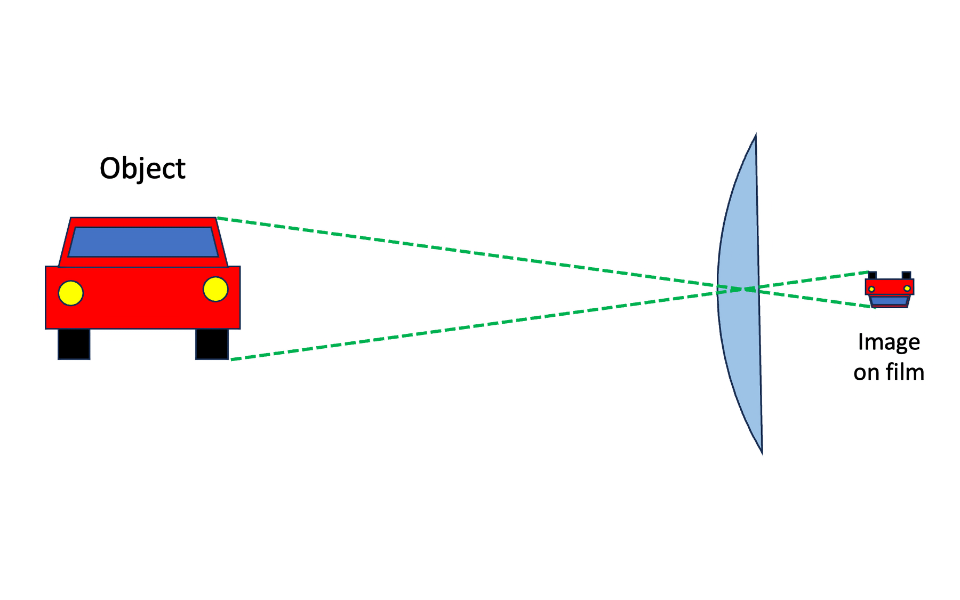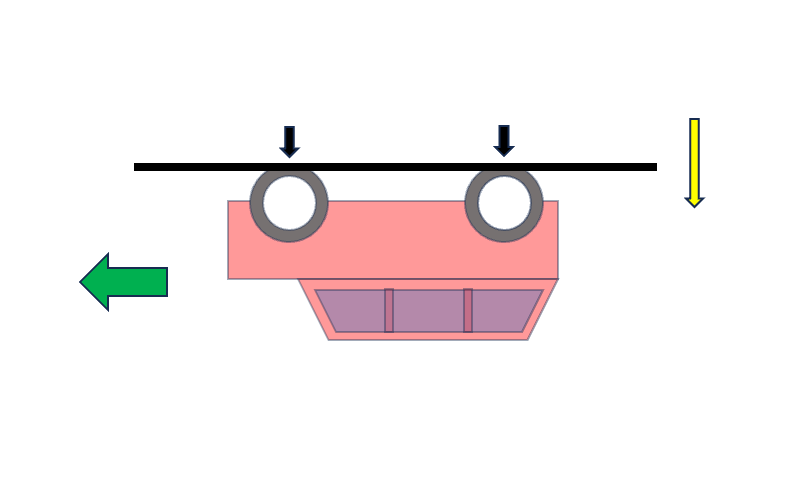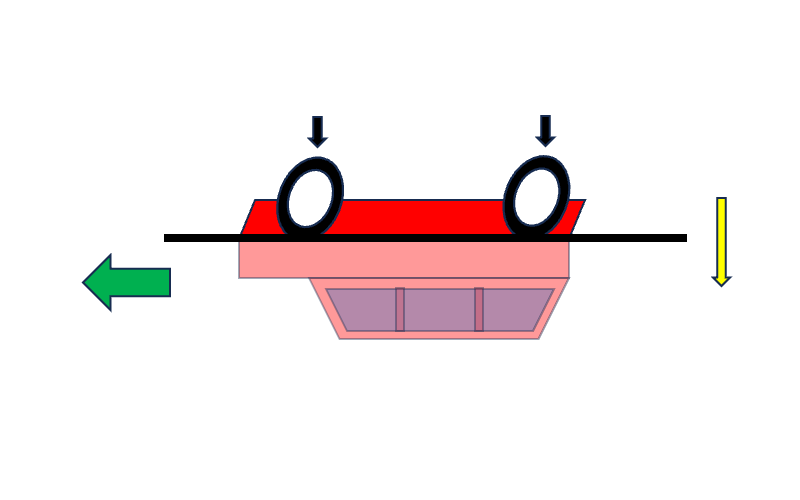

Cartoon race cars are often drawn as if they were leaning forward, with their circular wheels stretched into tilted ellipses; an Internet search for "cartoon race car" stock images will quickly lead you to many examples (the one above is from Clipart Library, licensed for personal use). I used to think this was just to give the impression of headlong rushing, like a human sprinter leaning ahead of his or her legs; however...

...it turns out that they actually look this way in the real world! At least, they do when photographed with a Graflex Speed Graphic camera, which was a very popular press camera in the first half of the 20th century. Note the vertical telephone pole and bell tower of the church across the street, with the zooming car in the foreground leaning distinctly forward in the direction of its motion.

This is my 1949 Pacemaker Speed Graphic camera; it takes flat sheets of 3 1/4" x 4 1/4" film, which is no longer commercially available, but luckily I have an adapter that lets me shoot a slightly smaller frame on modern 120-format roll film. The "collar" around the lens with knobs and levers is a shutter that closes the light path through the lens, then opens it momentarily to illuminate the whole film plane with exposures as fast as 1/400 second; the "speed" part of the camera's name indicates that it also has a curtain shutter at the focal plane, like a typical 35mm camera, which can give exposures as fast as 1/1000 second. This was faster than any in-lens shutter of which I'm aware when the camera was made, and the ability to freeze action made such cameras popular with professional news photographers -- I'm sure you've seen Speed Graphics, often with a big circular flash-bulb attachment, in movies from that era. Like a Checker Cab, they're instantly recognizable classics.

The focal-plane shutter is a simple, rugged mechanism consisting of a spring-loaded cloth curtain with three slits in it of varying widths; here I am holding it half-cocked to show the narrowest slit. When you wind and trigger the shutter, this slit moves over the film plane from top to bottom; since each bit of the film is only exposed to light when the slit is over it, and since the slit is not as wide as the film itself, the effective exposure is only a fraction of the time it takes the curtain to move the width of the film. (The back of the camera, where the focusing screen or film sits, is removed here to show the shutter.)

The reason that speeding cars appear to lean in photos shot with this camera has to do with movement of the image during the period of the exposure. The first thing to note is that, as in this diagram (not to scale), the image of an object seen through the lens is upside down at the position of the film.

You can see that this is the case by putting a ground-glass focusing screen in place of the film holder and looking at the live image focused on it, as here. (The image can be somewhat dim, so the focusing screen has a sunshade attached, also visible to the left in the first photo of the camera above.)

Since the image is inverted and the shutter slit moves from top to bottom, the slit will first expose the film with an image of the bottom of the vehicle's tires. This is shown schematically here, with the horizontal black line indicating the position of the slit as it allows light through to the film.

As the shutter slit moves down (yellow arrow), the image of the vehicle is moving forward (green arrow), and so in this diagram of the middle of an exposure the slit is letting through light from a strip of the vehicle that has moved horizontally compared to where it was at the start of the exposure (note relative positions of black arrows at exposed positions of bottoms of tires and semi-transparent upper section of the vehicle not yet exposed). Thus, if the vehicle travels fast enough that its image on the film moves a noticeable amount during the time it takes the shutter slit to cross the whole vertical extent of that image, the exposed image leans!

The amount of lean increases with the speed of the vehicle's image across the film. The two vehicles in this photograph were moving at about the same road speed (in opposite directions), but since the van is farther away than the SUV its image does not appear to move as fast over the film as that of the SUV in the foreground, and its wheels do not appear to lean forward as steeply.

In some old photos taken with such a camera, you will see the opposite effect, as here. For this shot I removed the camera from the tripod and triggered the shutter as I panned to follow the Jeep in the foreground. Thus the images of the buildings and telephone poles in the background were moving across the film as the shutter traveled, and thus they lean instead of the vehicle. You'll also notice that the background is somewhat blurred here while the vehicle is sharp, whereas the opposite was true in the tripod-mounted photos above; this is because whichever part of the image moves over the film between slit positions, as in the two diagrams above, is also moving during the brief period when the slit is over any given location of the film. There is a speed-reducing governor that can be engaged to slow the narrow-slit exposure from 1/1000 to 1/500 second, and the 75-year-old spring in my camera is a bit fatigued so the actual exposure is about 1/300 second, which is enough time to blur just a bit at each point. (The slit is about 1/10 the width of the film, so the 1/300 second exposure results from the slit traversing the film from top to bottom in about 1/30 second.)
An exercise for the reader: what would happen if I turned the camera 90 degrees, so that the shutter ran sideways? It's on my bucket list to build such a camera, with a slower focal-plane shutter to exaggerate the effects, and play with the results...
 Back
To Home Page
Back
To Home PageAll content copyright 2019-2024 by Mark Looper, except as noted. Reuse of my copyrighted material is authorized under Creative Commons Attribution 4.0 International license (CC BY 4.0).
![]()
![]()
New 1 January 2024